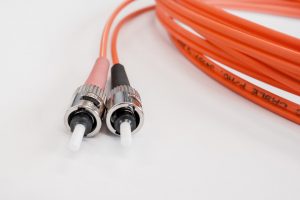
Also known as optical fiber cable, fiber optic cable is a type of data-transmitting cable that’s characterized by the use of one or more optical fibers. It’s made of optical fibers, which themselves are made of either glass or plastic, that allow for the high-speed transmission of data between two or more devices.
Traditionally, cables used for telecommunications applications have been made of copper. While copper cables are still used, many businesses and consumers have since switched to fiber optic cable. So, what makes fiber optic cable preferred over copper cable? To better understand its newfound popularity, you must first look at the construction of fiber optic cable.
How Fiber Optic Cable Is Constructed
There are different types of fiber optic cable, some of which consists of just a single strand of optical fiber, while others consist of up to 100 strands of optical fiber. Regardless, they are all made of a transparent fiber that’s roughly the same width as a strand of a human hair. Optical fiber is more effective at transporting data over long distances, making fiber optic cable ideal for telecommunications purposes.
The optical fiber used in this high-speed telecommunications cable is comprised of either glass or plastic. For applications in which speed or distance isn’t a concern, plastic optical fiber is used. For other applications, glass optical fiber is used. Either plastic or glass can be used to create optical fiber, but cables consisting entirely of glass deliver faster speeds than their counterparts made of plastic.
The Blazing-Fast Speeds of Fiber Optic Cable
Fiber optic cable typically delivers faster data transmission speeds than traditional copper cables because it transports data in the form of light. Sound confusing? Consider this is an example: If you shine a flashlight down a hallway with mirrors covering the wall, the light will bounce off the mirrors before reaching the end of the hallway. Fiber optic cable uses a similar principle to achieve superior data transmission speeds. Light bounces off the inside walls of the fiber optic cable until it reaches the end of the cable and, therefore, the connected device.
While speeds vary, it’s not uncommon for fiber optic cable to deliver 1 Gbps data transmission speeds, meaning you download files at a rate of 1 gigabyte per second when connected to fiber optic cable. In comparison, coaxial cable — traditional cable made of copper — tends to yield speeds of around 3 Mbps to 50 Mpbs.
